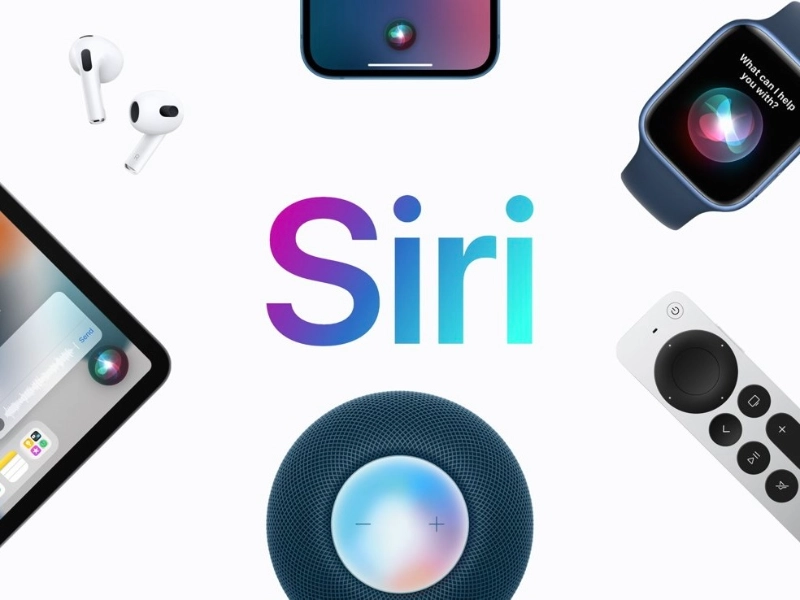- Siri is Apple’s voice-activated digital assistant.
- Developed by Apple, Siri made its debut in October 2011 with the launch of the iPhone 4S.
- Siri is designed to assist users with a wide range of tasks, including setting reminders, sending messages, making phone calls, scheduling appointments, and more.
Siri, Apple’s digital assistant, operates across various Apple operating systems, responding to voice commands, gestures, and natural language. Siri’s functionalities include managing phone actions, web searches, and interactions with third-party apps.
What is Siri?
Siri, Apple Inc.’s digital assistant, presents across various operating systems like iOS, iPadOS, watchOS, macOS, tvOS, audioOS, and visionOS. It responds to voice queries, gestures, and a natural-language interface, performing tasks by connecting to Internet services. Over time, Siri adapts to individual users’ language patterns and preferences.
Initially developed by the SRI International Artificial Intelligence Centre, Siri’s speech recognition engine comes from Nuance Communications, leveraging advanced machine learning. Voice recordings from American, British, and Australian actors, made around 2005, were repurposed for Siri. Originally released as an iOS app in 2010, Apple acquired Siri two months later, integrating it into the iPhone 4s in 2011. Since then, Siri has become a key component of Apple’s product lineup, extending to devices like iPhones, iPads, Macs, AirPods, Apple TV, HomePod, and Apple Vision Pro.
Siri’s capabilities encompass a wide array of tasks, from managing phone actions to searching the Internet and interacting with third-party apps. In 2016, Apple opened limited third-party access to Siri, allowing interactions with messaging, payments, ride-sharing, and Internet calling apps. Subsequent updates, such as iOS 11, introduced enhancements like improved voice, follow-up questions, language translation, and expanded third-party actions.
Also read: Apple’s Vision Pro headset: Global expansion and advanced VR features
How Siri works?
With a tap, press, or wake command, Apple’s intelligent assistant springs into action seamlessly across all Apple devices. The ubiquitous wake phrase “Hey Siri” grants users the ability to issue commands or make inquiries from virtually any Apple device.
In iOS 17 and the HomePod Software Version 17, the “Hey” prefix has been omitted, enabling users to simply say “Siri” followed by their command.
When you speak, your command undergoes local processing to determine if it can be executed on the device itself. If not, it is securely transmitted to an Apple server with a randomly generated identifier. All voice data is end-to-end encrypted, ensuring that synced data remains private and inaccessible to any potential eavesdroppers, whether from Apple or any other entity.
Devices await the wake word and conduct checks to determine which one should respond. Siri’s intelligent capabilities rely on machine learning for various tasks. It can identify and propose calendar appointments found in emails or messages, suggest relevant web pages in Safari based on links shared in iMessage, and provide intelligent text suggestions derived from recent website visits or news articles the user has engaged with. Furthermore, Siri will offer recommendations for tasks that are frequently performed or typically occur at specific times of the day.
Third-party developers have the opportunity to leverage Apple’s APIs (Application Programming Interfaces) and develop their own integrated functionalities. Devices such as the HomePod were subject to scrutiny from regulators who believed Apple was showing undue favouritism towards its own services. However, with access to APIs, companies can now incorporate services like Spotify into the HomePod, fostering a more open ecosystem.
Also read: Apple Siri team given choice: Move office with $7,000, or get fired
Functions of Siri
Siri excels in performing a variety of basic commands and tasks, simplifying everyday activities for users. Users can use Siri to set reminders, create calendar events, send text messages, make phone calls, and set alarms. Siri’s natural language processing capabilities allow users to interact with it in a conversational manner, making it easy to communicate their intentions and preferences.
One of Siri’s key functions is its ability to retrieve information and perform web searches on behalf of users. Users can ask Siri questions on a wide range of topics, such as general knowledge, weather forecasts, sports scores, and factual inquiries. Siri leverages various sources, including Apple’s own databases and the internet, to provide accurate and up-to-date information in response to user queries.
Siri serves as a versatile tool for accessing multimedia content and entertainment options. Users can use Siri to play music, podcasts, audiobooks, and radio stations, either from their device’s library or through streaming services like Apple Music. Siri can also provide recommendations for movies, TV shows, restaurants, and local attractions based on user preferences and location data.
With the rise of smart home devices, Siri has expanded its functionalities to include home automation and control. Users can use Siri to control compatible smart home devices, such as lights, thermostats, locks, and cameras, using voice commands. Siri’s integration with Apple’s HomeKit platform allows for seamless setup and management of smart home accessories, offering convenience and ease of use for users.
Siri enhances productivity and organisation by helping users manage their tasks, appointments, and reminders. Users can use Siri to create and update calendar events, set timers and alarms, and manage to-do lists and reminders. Siri’s ability to understand natural language commands makes it easy for users to dictate notes, emails, and messages hands-free, streamlining their workflow and saving time.
Siri includes a range of accessibility features to support users with disabilities or special needs. Users can use Siri to enable and configure accessibility settings, such as VoiceOver, Magnifier, and AssistiveTouch, to enhance their device usage experience. Siri’s voice recognition and dictation capabilities offer alternative input methods for users with mobility impairments or visual impairments, empowering them to navigate and interact with their devices more effectively.

